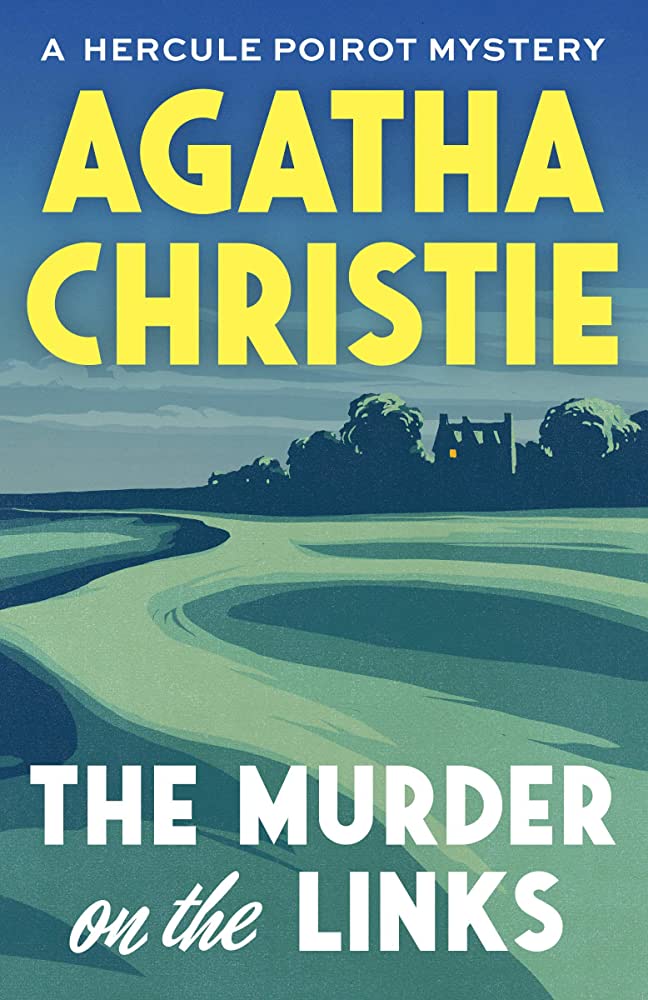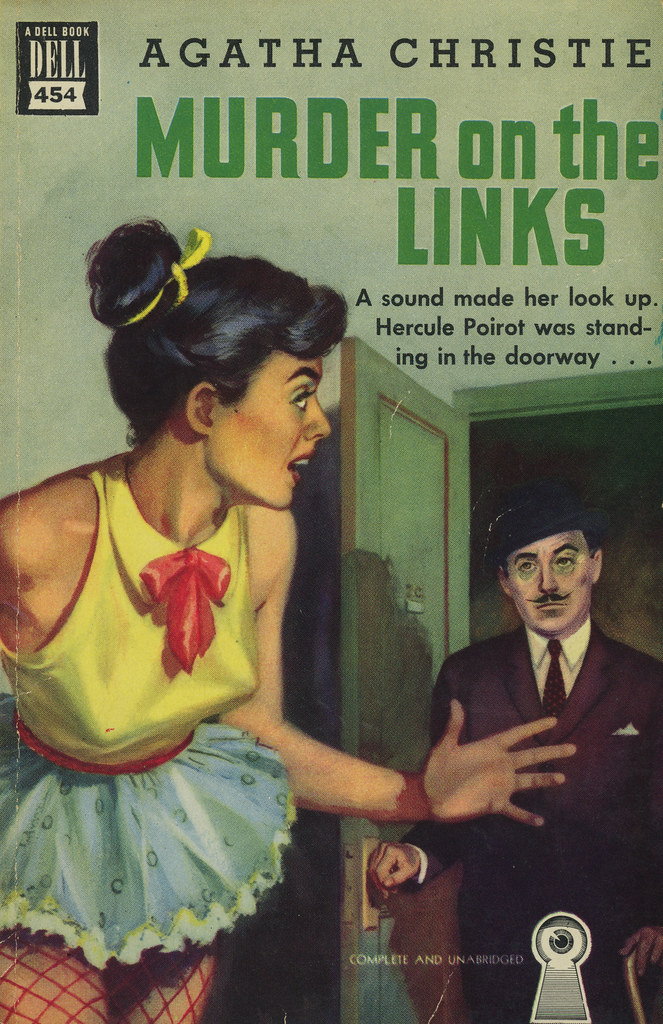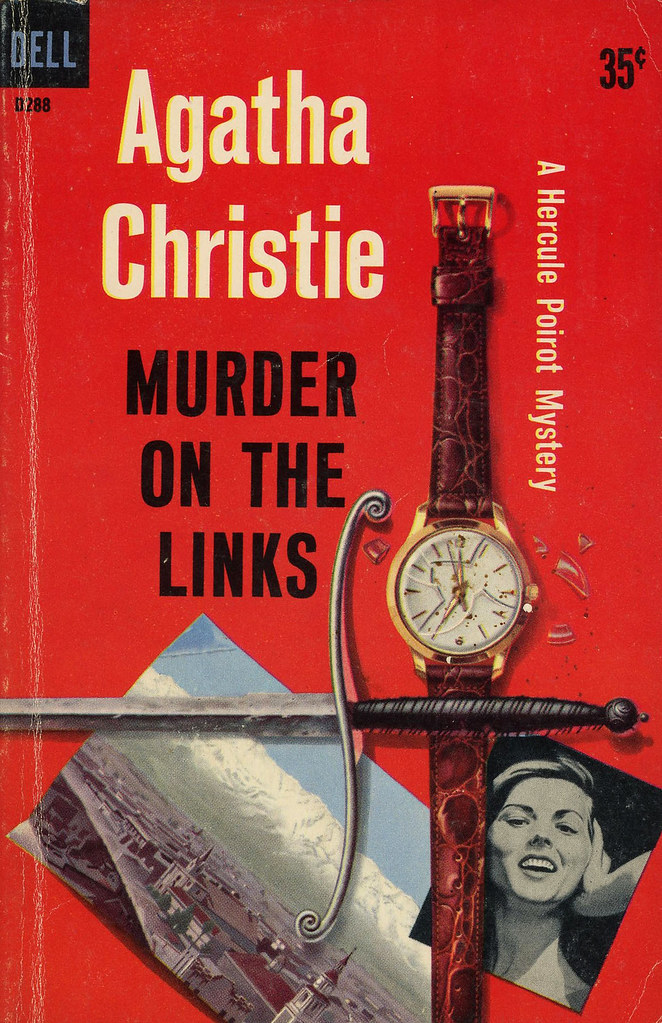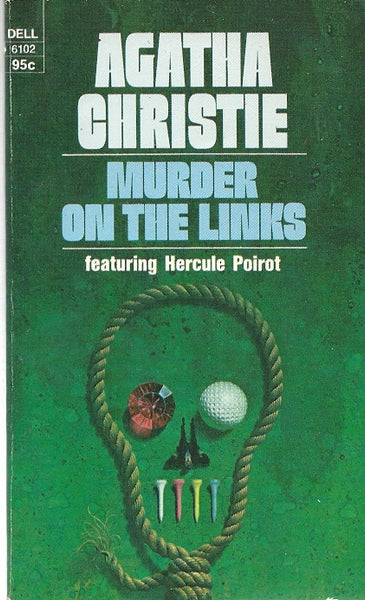“When Conan Doyle popularized Sherlock Holmes in The Strand of the nineties, he lit such a candle as the publishers will not willingly let out. Not a week passes which does not bring a ‘detective’ story from one quarter or another, and . . . among the later cultivators of this anything but lonely furrow the name of Agatha Christie is well in the front. If she has not the touch of artistry which made “The Speckled Band” and The Hound of the Baskervilles things of real horror, she has an unusual gift of mechanical complication. . . (However) it is a mistake to carry the art of bewilderment to the point of making the brain reel.” From the review of The Murder on the Links in The Observer, June 10, 1923
All the best mystery authors get better as they go along, but the extraordinary thing about Agatha Christie is how good she was from the start. The Mysterious Affair at Styles may be a trifle long, and its solution may depend, at least partly, on a bit of scientific fact that the average reader may know nothing about and one incriminating letter that springs out of nowhere (“No one can possibly bring home the crime to me. That idea of yours about the bromides was a stroke of genius . . . “). But its structure is sound, its country-house characters varied enough – and its detective-hero is sublime.
Interesting then that she chose not to settle on one formula but to experiment within her chosen genre. Granted, the 1920’s were a tumultuous decade for Mrs. Christie personally, and this affected the quality of her work. But before 1930, when she settled down to become what she would describe as “a perfect sausage machine” and we would call the creator of an extraordinary and diverse body of crime fiction, Christie was all over the place with what she wrote.
The 20’s saw the debut of all her main series detectives (although Miss Marple only appeared in magazines). It gave us what many fans consider her best female-in-danger thriller (The Man in the Brown Suit), an early book that plays with narrative structure in auspicious ways. Christie also gifted us with a double-bill: the ponderous Secret of Chimneys and the souffle-light, rather clever Seven Dials Mystery (with the glorious Superintendent Battle helping out).
Mostly, she gave us Poirot – but even then Christie displayed diversity. Styles is a country-house whodunnit, The Big Four and The Mystery of the Blue Train give us contrasting thrillers involving criminal masterminds. Four is ridiculous but fun in an Edgar Wallace way; Train is more focused (yes, it is!!) but often dull. And then there’s The Murder of Roger Ackroyd, whose brilliance changed everything . . . just not for a little while until after the Christie marriage exploded.
Today, however, we gather to sing the dubious praises of The Murder on the Links, Agatha Christie’s third novel and her second book about Poirot, which celebrates its centenary this very month. I’m going to be honest upfront: I love Christie, you all know I do, but there is a small handful of her books that do nothing for me. The aforementioned Chimneys is one, and those painful final novels, Passenger to Frankfurt and Postern of Fate are books which arguably should never have been published. Mostly, even with the weaker novels, there are things I can find to love: Ariadne Oliver’s presence provides a certain measure of fun in Third Girl and Elephants Can Remember, despite the tired recycling of old puzzle tropes in the former and a lack of – well, almost everything good in the latter. Even the political thrillers, my least favorite sub-genre of Christie, all have some enjoyable elements, whether it’s a character (Hilary Craven in Destination: Unknown), a twist (the end of that same book or the identity of Victoria’s nemesis in They Came to Baghdad, or a fantastic pair of heroes and a sense of fun throughout (The Secret Adversary).
The Murder on the Links . . . well, it’s a detective story where the rest of these are not. And it does contain some elements one can enjoy: we get a spicy little romance for Hastings that ends in marriage and – perhaps Agatha’s intention – Hastings’ eventual exit from the series. We’re also still hanging with early Poirot, so he analyzes five clues per page and leaps about like a cat (no, literally he climbs up a tree and springs through an open window “with the agility of a cat!” Perhaps this is the version of Poirot whom Kenneth Branagh is playing.) He engages in a lively competition with a rival detective: Giraud, the great French sleuth from the Paris Sureté. It’s a rivalry which pushes Poirot away from his early focus on tangible clues (which Giraud loves) and, for the rest of his career moves the emphasis onto human psychology.
In her biography of Christie, Laura Thompson contrasts the very British Styles with this sequel, calling Links “very French, not just in setting but in tone . . . (it) reeks of Gaston Leroux and, at times, Racine . . .” I suppose that is true: here, Poirot and the legion of police characters who populate the book all bow to each other politely. Every page contains expressions françaises that are sprinkled liberally tout au long de la page and are printed in italique to distinguish them from the English words. Some humor is wrung from the fact that poor Hastings is surrounded by people who parler comme Poirot and have un mauvais avis about the English. N’est ce pas?
As I write these commentaries on Christie’s stories, it has become a habit of checking in with John Curran’s double volume opus on Agatha Christie’s Secret Notebooks to find out what the author herself was thinking as she plotted a particular book, what sparked the original idea, how it gained its shape – even, occasionally, what might have been. (Miss Marple on the Nile? There’s a parallel universe somewhere where this exists . . . ) It is a great disappointment to discover that Links is one of only five books for which no notes exist, and I can only imagine this plot unfolding and refolding and finally folding in on itself over a great many pages.
I had originally intended to do a deep dive into the book’s plot for you, but you don’t really need me for that. I might turn your attention to the late John Goddard’s Agatha Christie’s Golden Age, which dissects the plot and solution brilliantly. No, I’m just going to do what my great-Aunt Helen would do on her own birthday: complain a bit and then blow out the candles.
Ronald Knox’s Tenth Commandment of crime fiction states: “Twin brothers, and doubles generally, must not appear unless we have been duly prepared for them.” In Links, Christie breaks this rule – twice. The first time, the one involving actual twin sisters, is almost forgivable because, although it does have some bearing on the case, its main purpose is to add spice and poignancy to Hastings’ love story. The point where he wraps his arms around Poirot to allow his beloved to escape, not realizing that she is the innocent sister (well, both of them are innocent but – oh, who cares?) is a nice moment near the end. But the real double for which we are completely unprepared is the murder plot that turns out to be the repeat of a much earlier case which rests in Poirot’s memory until the moment he needs to pluck it out and present it to his aghast fellow policemen (and a few shocked readers, I suppose.) It’s a point where Christie doesn’t play fair – not that she didn’t commit the same crime during Styles – but the book’s entire plot rests on a reversal of our expectations that relies on the knowledge that the victim, Paul Renaud, has done all this before.
The drama in Styles is very English, resting largely on a family that doesn’t express its feelings. Will John and Mary’s marriage withstand the murder and their own inability to talk to each other? Will Lawrence ever find the words to tell Cynthia how he really feels? As for Hastings, it takes a Belgian to explain that everything he thinks he knows about these characters – including his belief that both Mary and Cynthia have feelings for him – is wrong.
Meanwhile, as Laura Thompson suggests, the drama in Links is très French. On the night of the murder, an assortment of beautiful women are traipsing all over the house and grounds. Paul Renaud is linked to three of them, while his son can lay claim to two. (With one overlap – very French!) In the early moments of the investigation, Poirot and Company cannot keep from tripping over clues: the love letter in the dead man’s pocket, the scrap of paper with the name “Duveen” caught under the rug, the long dark hair of a femme fatale found in the study. Various servants fall over themselves to reveal the comings and goings of various women to the Villa Geneviève.
It’s all very lively at the start, from Hastings’ initial “meet-cute” with his future “Cinderella” on the train to he and Poirot quickly acquiescing to Renaud’s urgent summons. The initial set-up is intriguing, even if it never approaches the emotional horror of Mrs. Inglethorpe’s death. M. Renaud is found lying face down in a freshly dug open grave located on the golf course next to his villa, while his wife is discovered trussed up with rope in their bedroom, babbling a story about Chilean criminals entering and overpowering the couple. Is this a Spanish Mafia crime? Maybe so . . . but downstairs, the old servant Francoise recounts a visit that from the alluring and mysterious neighbor Madame Daubreuil, who lives with her beautiful daughter Marthe, “a girl with anxious eyes,” while the younger servant Denise tells of another woman’s visit, this one much younger and lovelier.
Ooh la la! But then the case gradually bends and twists and folds itself into un bretzel. Right away, Poirot had deduced something off about the intent of Renaud’s letter, and in the end he is proven correct. Except that “proven” denotes evidence, and so much of the plot of Links hangs on memories snatched from air and fabulous strokes of luck on the part of every plotter in this game. Even John Goddard, a retired lawyer with a brilliant mind for taking apart Christie’s most complex plots, found himself baffled
“. . . about chapter 20. There the narrative gets so tortuous with theories and clues, and being knocked about by Poirot and Hastings, that it becomes hard to follow the thinking and harder still to work out what really matters. Hastings’ admission that he is hopelessly fogged is entirely justified.”
I think that last sentence says it all: when one can actually empathize with the obtuse Captain Hastings, then perhaps the author’s work isn’t quite passing muster. Again these are early days in the Christie oeuvre, when the depths of her characterization centered on her sleuths. But as much as I love Poirot here (and tolerate Hastings), I don’t really care about any of the other characters, including the women. And one of Christie’s gifts was her ability to create an interesting assortment of women in her books. Think about the passengers on the Orient Express and the S.S. Karnak; think about the villagers in any Miss Marple mystery.
Here, though, there is not much to differentiate the cast. One of the women is Madonna-esque, one is tres chic, and one has “anxious eyes.” Only “Cinderella” comes to life a bit in her brief appearances, and this is necessary if we are going to give our blessing to the union between this modern-day Watson and his future wife. Meanwhile, the men scarcely appear in the novel; in fact, there are very few suspects to choose from at all. And there is nobody particularly “clever” to admire, even criminally: the complicated plot ends up resting on two fortuitous circumstances, the first being the entry into the story of a convenient tramp who could pass for Renauld (and who chooses to die of epilepsy on the grounds just when his body was most needed!), and the second being Jack Renauld’s propensity for giving knives to all his girlfriends!
Ooh la . . . la la la!
So let us celebrate The Murder on the Links for what it was: a flawed but important step in the evolution of Poirot. Of course, if Links was “one small step,” then Roger Ackroyd became “one giant leap” that truly benefited all the humankind of Christie fans throughout time and space. Et voila . . . Happy Birthday!





I didn’t like this one much when I first read it a long time ago and so never re-read it. I decided to revisit it a couple of years ago, and I had the same reaction in that it still didn’t impress me. I wish I could recall why in more detail, but I believe one issue is that it was too muddled and confusing, as you mentioned.
LikeLiked by 1 person
Honestly, I forget it all from year to year. Poirot is great – a real action hero who turns from buttons and hair follicles to behavioral analysis before our eyes – but the case itself is both too much and not enough to sustain me.
LikeLike
I am not familiar with the novels of the time, but I suppose someone might find that Christie subverts romantic tropes, and creates a surprising solution in that way.
LikeLiked by 2 people
SPOILERS:
That’s a great point, Johan, and I’m sure you’re onto something. With two middle-aged femmes fatales and rambunctious twins, one figures that the lovely Marthe will end up with Jack when all this is over. To discover that she is just as scheming and self-serving as her mother must have come as a surprise to contemporary readers, especially since this is the first “killer ingenue” in Christie’s canon. That there will be MUCH better ones in the future is to be expected, given her constant growth as a writer and plotter through the first half of her career.
LikeLike
I didn’t care for this one much when I read it for the first time but I reread it more recently for – er – reasons – and found more to enjoy in it. It’s certainly weaker Christie, and some of the best bits are only there to obfuscate the main murder plot (the switched coats is a delightful little red herring), which makes the whole thing feel too clever by half. While the references to Leroux and other French writers is sound, I feel that this novel is the one for which Christie is most indebted to Arthur Conan Doyle. The plot has strong echoes of “The Abbey Grange” and, as you suggested, young Poirot really acts a lot more like Holmes than he does anywhere else in the Christie Canon. For that reason I think it’s unique to see Christie before she forged a path on her own and her own style.
LikeLiked by 1 person
It’s funny: I really was going to put much more in here about the Doyle connection (no, really!!). I had even started the piece with a quote by Christie from An Autobiography about the influence of Holmes on her creation of Poirot. But I figured (or was hopeful) that a certain Doyle expert might happen by and chime in. Makes me that much less wordy . . . 🙂
I agree that this feels very Holmesian. Hastings’ romantic subplot feels like a dramatization of Watson’s private life (and a LOT of this found its way into later Holmes adaptations by other writers). Then that opening bit where Poirot keeps uncovering clues that lead to conclusions, from Renaud’s letter to a dozen bits and pieces he finds at the villa, is just like Sherlock who can’t stop analyzing. I really do think that this is the point where Poirot, disgusted with the “tangible clue expert” from the Surete, starts to branch out more into psychological deduction. Not that Holmes didn’t ever do this, but from here on in it will become a bigger percentage of Poirot’s bag of tricks.
LikeLike
The Murder on the Links has, I think, dated badly. It’s very much of its time, rather melodramatic, and isn’t as clever as Styles or Ackroyd. But when it came out, it was lauded.
Both Winifrid Blatchford (Clarion) and S. P. B. Mais (Daily Express) considered it one of the best detective stories they had ever read. “Agatha Christie stands in a class by herself as a writer of detective stories,” Mais declared. (By that stage, of course, the Poirot Investigates and Early Cases short stories were being published in the Sketch.)
J. D. Symon (Illustrated London News) already praised her talent for misdirection:
“If one were asked to name the chief characteristic of Mrs. Christie’s method, it would be her power of suspense and concealment. She is very cunning at putting the reader off the scent. It may be possible sometimes to spot Mrs. Christie’s criminal, before the final revelation (I can without boasting claim to have done so, never mind in what book or short story), but in The Murder on the Links I was completely thrown off the track. One ought not to have been, but there it was.
…
“The dénouement came with an unblanketed shock of surprise. A story that can keep its secret to the very end is rather rare, and when such a tale comes along it is a godsend to hardened readers of fiction.”
Nearly all the reviews were enthusiastic. Only one, The Observer, found it rather convoluted. “One realises, on turning back from about the seventh false clue, that it is a mistake to carry the art of bewilderment to the point of making the brain reel. Perhaps a simple detective story is a contradiction in terms, but it is possible to be fatigued with wandering up and down blind alleys.”
LikeLike
I’m never quite certain why some books of the Golden Age feel so much more dated than others.
LikeLiked by 1 person
I’m not an expert by any means, but I would like to point out two possible reasons: first, as Nick points out above, this novel reveals how inspired and influenced by Doyle Christie was. Even more than The Mysterious Affair at Styles, this feels more like a Sherlock Holmes adventure. Interestingly, the same month this came out, the Sketch magazine started publishing the Poirot short stories that would be compiled in the U.S. the following year as Poirot Investigates, which in style is the most “Holmesian” collection in her canon.
Secondly – and probably more an adjunct to the first – is the fact that Hastings narrates this. He is a stuffy old son-of-a-gun. In fact, upon meeting his “Cinderella” (who has yelled “Hell!” in their train compartment), he describes himself thusly:
“ Now, I am old-fashioned. A woman, I consider, should be womanly. I have no patience with the modern neurotic girl who jazzes from morning till night, smokes like a chimney, and uses language which would make a Billingsgate fishwoman blush!”
I think Hastings is stuffier here than in any other of the novels in which he appears, but that’s just my opinion.
Oh, and a third thought: since this is set in France, Christie has all the women running around being sexy and femme fatale-ish in the most old-fashioned ways. They are the least interesting assortment of female characters I’ve encountered in the work of a woman who normally wrote wonderful female characters.
LikeLiked by 1 person
Spoilers for Murder on the Links and Secret of Chimneys:
“Now, I am old-fashioned. A woman, I consider, should be womanly. I have no patience with the modern neurotic girl who jazzes from morning till night, smokes like a chimney, and uses language which would make a Billingsgate fishwoman blush!”
This is the only part in Murder on the Links, that for me actually works really well, because Christie reversed it both by having Hastings marry exactly such a woman and because of the killer’s identity. Everything else is a mixture of overcomplicated and not all that interesting. IMO, even the maligned thrillers of the 20s have more to offer. Even Chimneys, which I don’t like much, is arguably an early version of the policeman being a villain. Though I never quite got how much he is in it, which is one of the reasons why I dislike Chimneys.
LikeLiked by 1 person
Chimneys is the Christie I know least, having barely read it only once. I meant to re-read it when All About Agatha revisited it, but life intervened. One day . . .
LikeLike
I recognize how flawed the plot of LINKS is, but I like its use of a rarely employed deception (that Christie admittedly used to greater advantage in later, better, novels), basically the faulty syllogism that:
If X is the killer, then X is a not an honest character
X is not the killer,
Therefore, X is an honest character.
Basically the misleading idea that, since the victim is distinct from the killer, he must be seen as a truthful and reliable source of info. It’s a cool idea, not overused, and beautifully employed in at least a couple of her later works. To my knowledge, this was her first use of it.
LikeLike
Indeed, solely as a plot device, I prefer it to that of The Murder of Roger Ackroyd, though needless to say, thr execution of it is not nearly as strong!
LikeLike
Of course what deceives someone in a mystery novel is always subjective. One person’s surprise is that the other one’s obvious solution. But nonetheless I have to say, the victim being dishonest was obvious to me was obvious from the moment Poirot gets the letter with the dramatical ending, that was so clearly calculated.
LikeLiked by 1 person
Pingback: MY AGATHA CHRISTIE INDEX (The Blog-iography!) | Ah Sweet Mystery!